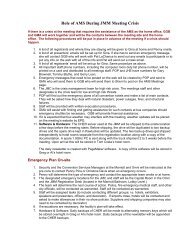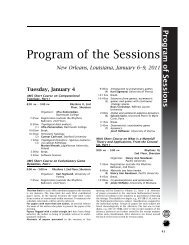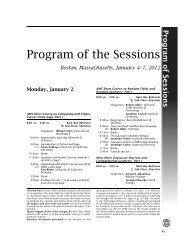Gaussian Kinematic Formula and the integral geometry of random sets
Gaussian Kinematic Formula and the integral geometry of random sets
Gaussian Kinematic Formula and the integral geometry of random sets
Create successful ePaper yourself
Turn your PDF publications into a flip-book with our unique Google optimized e-Paper software.
<strong>Gaussian</strong><strong>Kinematic</strong><strong>Formula</strong> <strong>and</strong><strong>the</strong> <strong>integral</strong><strong>geometry</strong> <strong>of</strong>r<strong>and</strong>om <strong>sets</strong>JonathanTaylorStanfordUniversity<strong>Gaussian</strong> <strong>Kinematic</strong> <strong>Formula</strong> <strong>and</strong> <strong>the</strong> <strong>integral</strong><strong>geometry</strong> <strong>of</strong> r<strong>and</strong>om <strong>sets</strong>Jonathan TaylorStanford UniversityNovember 11, 20111 / 41
<strong>Gaussian</strong><strong>Kinematic</strong><strong>Formula</strong> <strong>and</strong><strong>the</strong> <strong>integral</strong><strong>geometry</strong> <strong>of</strong>r<strong>and</strong>om <strong>sets</strong>JonathanTaylorStanfordUniversityOutlineA model for r<strong>and</strong>om <strong>sets</strong>.Some old <strong>integral</strong> <strong>geometry</strong>.<strong>Gaussian</strong> <strong>integral</strong> <strong>geometry</strong>.Accuracy <strong>of</strong> approximation.2 / 41
R<strong>and</strong>om <strong>sets</strong><strong>Gaussian</strong><strong>Kinematic</strong><strong>Formula</strong> <strong>and</strong><strong>the</strong> <strong>integral</strong><strong>geometry</strong> <strong>of</strong>r<strong>and</strong>om <strong>sets</strong>JonathanTaylorStanfordUniversity<strong>Gaussian</strong> processes: basic building blocksTwice-differentiable <strong>Gaussian</strong> process (f t ) t∈MM.Satisfying:E{f t } = 0;E{f 2t } = 1.on a manifoldWhy <strong>Gaussian</strong>?<strong>Gaussian</strong> processes are specified by mean <strong>and</strong> covariancefunction.Finite-dimensional distributions are all simple –multivariate <strong>Gaussian</strong>.3 / 41
R<strong>and</strong>om <strong>sets</strong><strong>Gaussian</strong><strong>Kinematic</strong><strong>Formula</strong> <strong>and</strong><strong>the</strong> <strong>integral</strong><strong>geometry</strong> <strong>of</strong>r<strong>and</strong>om <strong>sets</strong>JonathanTaylorStanfordUniversityExcursion <strong>sets</strong>R<strong>and</strong>om <strong>sets</strong> we will consider are <strong>of</strong> <strong>the</strong> form:f −1 A = {t ∈ M : f t ∈ A}for A ⊂ R. In particular, <strong>the</strong> <strong>geometry</strong> <strong>of</strong> <strong>the</strong>se <strong>sets</strong>, <strong>and</strong> how itis determined by correlation function <strong>of</strong> f .4 / 41
Excursion above 0<strong>Gaussian</strong><strong>Kinematic</strong><strong>Formula</strong> <strong>and</strong><strong>the</strong> <strong>integral</strong><strong>geometry</strong> <strong>of</strong>r<strong>and</strong>om <strong>sets</strong>JonathanTaylorStanfordUniversity5 / 41
Excursion above 1<strong>Gaussian</strong><strong>Kinematic</strong><strong>Formula</strong> <strong>and</strong><strong>the</strong> <strong>integral</strong><strong>geometry</strong> <strong>of</strong>r<strong>and</strong>om <strong>sets</strong>JonathanTaylorStanfordUniversity6 / 41
Excursion above 1.5<strong>Gaussian</strong><strong>Kinematic</strong><strong>Formula</strong> <strong>and</strong><strong>the</strong> <strong>integral</strong><strong>geometry</strong> <strong>of</strong>r<strong>and</strong>om <strong>sets</strong>JonathanTaylorStanfordUniversity7 / 41
Excursion above 2<strong>Gaussian</strong><strong>Kinematic</strong><strong>Formula</strong> <strong>and</strong><strong>the</strong> <strong>integral</strong><strong>geometry</strong> <strong>of</strong>r<strong>and</strong>om <strong>sets</strong>JonathanTaylorStanfordUniversity8 / 41
Excursion above 2.5<strong>Gaussian</strong><strong>Kinematic</strong><strong>Formula</strong> <strong>and</strong><strong>the</strong> <strong>integral</strong><strong>geometry</strong> <strong>of</strong>r<strong>and</strong>om <strong>sets</strong>JonathanTaylorStanfordUniversity9 / 41
Excursion above 3<strong>Gaussian</strong><strong>Kinematic</strong><strong>Formula</strong> <strong>and</strong><strong>the</strong> <strong>integral</strong><strong>geometry</strong> <strong>of</strong>r<strong>and</strong>om <strong>sets</strong>JonathanTaylorStanfordUniversity10 / 41
Excursion above 3.3<strong>Gaussian</strong><strong>Kinematic</strong><strong>Formula</strong> <strong>and</strong><strong>the</strong> <strong>integral</strong><strong>geometry</strong> <strong>of</strong>r<strong>and</strong>om <strong>sets</strong>JonathanTaylorStanfordUniversity11 / 41
Euler characteristic<strong>Gaussian</strong><strong>Kinematic</strong><strong>Formula</strong> <strong>and</strong><strong>the</strong> <strong>integral</strong><strong>geometry</strong> <strong>of</strong>r<strong>and</strong>om <strong>sets</strong>JonathanTaylorStanfordUniversityWhat geometric features?We’re interested in <strong>integral</strong> geometric properties.Specifically, <strong>the</strong> (expected) Euler characteristicE { χ ( f −1 [u, +∞) )} = E { χ ( M ∩ f −1 [u, +∞) )}EC tells you very littleLet M be a 2-manifold without boundary, <strong>the</strong>nE { χ ( M ∩ f −1 [0, +∞) )} = 1 2 · χ(M)With boundary:E { χ ( M ∩ f −1 [0, +∞) )} = 1 2 · χ(M) + 12π · |∂M| 12 / 41
Euler characteristic<strong>Gaussian</strong><strong>Kinematic</strong><strong>Formula</strong> <strong>and</strong><strong>the</strong> <strong>integral</strong><strong>geometry</strong> <strong>of</strong>r<strong>and</strong>om <strong>sets</strong>JonathanTaylorStanfordUniversityEC is computableOf all quantities in <strong>the</strong> studies <strong>of</strong> <strong>Gaussian</strong> processes, <strong>the</strong> ECst<strong>and</strong>s out as being explicitly computable in wide generalityE { χ ( M ∩ f −1 [u, +∞) )} =dim(M)∑j=0L j (M)ρ j (u).Where do L j ’s <strong>and</strong> ρ j ’s come from?EC tells you a lotFor “nice enough” ME { χ ( M ∩ f −1 [u, +∞) )} }u→∞≃ P{sup f t ≥ ut∈M13 / 41
Euler characteristic<strong>Gaussian</strong><strong>Kinematic</strong><strong>Formula</strong> <strong>and</strong><strong>the</strong> <strong>integral</strong><strong>geometry</strong> <strong>of</strong>r<strong>and</strong>om <strong>sets</strong>JonathanTaylorStanfordUniversityAccuracyIf <strong>the</strong> parameter set is locally convex, <strong>the</strong>n}∣{sup P f t ≥ u − E { χ ( M ∩ f −1 [u, +∞) )}∣ ∣∣t∈M(u→∞ = Oexp e −u2 /2·(1+ 1 ))σc 2 (f )Since, ρ j (u) = O exp (e −u2 /2 ), <strong>the</strong> approximation hasexponential relative accuracy!14 / 41
Integral <strong>geometry</strong><strong>Gaussian</strong><strong>Kinematic</strong><strong>Formula</strong> <strong>and</strong><strong>the</strong> <strong>integral</strong><strong>geometry</strong> <strong>of</strong>r<strong>and</strong>om <strong>sets</strong>JonathanTaylorStanfordUniversityTube formulaeSuppose f is (<strong>the</strong> restriction } to M) <strong>of</strong> an isotropic process˜f , with Var{d˜f /dx i = 1.For small r, <strong>the</strong> functionals L j (M) are implicitly definedby Steiner-Weyl formula)H k(x ∈ R k : d(x, M) ≤ r =k∑ω k−j r k−j L j (M; M)j=015 / 41
Integral <strong>geometry</strong>: tubes<strong>Gaussian</strong><strong>Kinematic</strong><strong>Formula</strong> <strong>and</strong><strong>the</strong> <strong>integral</strong><strong>geometry</strong> <strong>of</strong>r<strong>and</strong>om <strong>sets</strong>JonathanTaylorStanfordUniversityH 3 (Tube([0, a] × [0, b] × [0, c], r))= abc + 2r · (ab + bc + ac) + (πr 2 ) · (a + b + c) + 4πr 3316 / 41
Integral <strong>geometry</strong>: tubes<strong>Gaussian</strong><strong>Kinematic</strong><strong>Formula</strong> <strong>and</strong><strong>the</strong> <strong>integral</strong><strong>geometry</strong> <strong>of</strong>r<strong>and</strong>om <strong>sets</strong>JonathanTaylorStanfordUniversity17 / 41
Integral <strong>geometry</strong>: tubes<strong>Gaussian</strong><strong>Kinematic</strong><strong>Formula</strong> <strong>and</strong><strong>the</strong> <strong>integral</strong><strong>geometry</strong> <strong>of</strong>r<strong>and</strong>om <strong>sets</strong>JonathanTaylorStanfordUniversityLocal convexity is important!Singularity means implicit definition is invalid, BUTL j (·) ′ s are still well defined . . .They are defined for a large class <strong>of</strong> <strong>sets</strong> . . .18 / 41
<strong>Gaussian</strong> processes<strong>Gaussian</strong><strong>Kinematic</strong><strong>Formula</strong> <strong>and</strong><strong>the</strong> <strong>integral</strong><strong>geometry</strong> <strong>of</strong>r<strong>and</strong>om <strong>sets</strong>JonathanTaylorStanfordUniversity19 / 41
Integral <strong>geometry</strong>: curvature measures<strong>Gaussian</strong><strong>Kinematic</strong><strong>Formula</strong> <strong>and</strong><strong>the</strong> <strong>integral</strong><strong>geometry</strong> <strong>of</strong>r<strong>and</strong>om <strong>sets</strong>JonathanTaylorStanfordUniversityH k−1 (exp ν (A ∩ ∂D, rν)) =k∑∫r j−1 · ω jj=1AL k−j (D; dp)20 / 41
Integral <strong>geometry</strong><strong>Gaussian</strong><strong>Kinematic</strong><strong>Formula</strong> <strong>and</strong><strong>the</strong> <strong>integral</strong><strong>geometry</strong> <strong>of</strong>r<strong>and</strong>om <strong>sets</strong>JonathanTaylorStanfordUniversity<strong>Kinematic</strong> Fundamental <strong>Formula</strong>Where else do we see L j (·)’s?21 / 41
Integral <strong>geometry</strong><strong>Gaussian</strong><strong>Kinematic</strong><strong>Formula</strong> <strong>and</strong><strong>the</strong> <strong>integral</strong><strong>geometry</strong> <strong>of</strong>r<strong>and</strong>om <strong>sets</strong>JonathanTaylorStanfordUniversity<strong>Kinematic</strong> Fundamental <strong>Formula</strong>Considers <strong>the</strong> “average” curvature measures <strong>of</strong> M 1 ∩ gM 2 ,i.e.22 / 41
Integral <strong>geometry</strong>: KFF<strong>Gaussian</strong><strong>Kinematic</strong><strong>Formula</strong> <strong>and</strong><strong>the</strong> <strong>integral</strong><strong>geometry</strong> <strong>of</strong>r<strong>and</strong>om <strong>sets</strong>JonathanTaylorStanfordUniversityThe KFF on R NIsometry group G N <strong>of</strong> rigid motions <strong>of</strong> R N ,G N ∼ R N ⋊ O(N)Fix a Haar measure:ν N ({g N ∈ G N : g N x ∈ A}) = H N (A)∫L i (M 1 ∩ g N M 2 ) dν N (g N )G NN−i∑[ ] [ ] −1 i + j N=Li j i+j (M 1 )L N−j (M 2 )j=023 / 41
Back to <strong>Gaussian</strong> processes<strong>Gaussian</strong><strong>Kinematic</strong><strong>Formula</strong> <strong>and</strong><strong>the</strong> <strong>integral</strong><strong>geometry</strong> <strong>of</strong>r<strong>and</strong>om <strong>sets</strong>JonathanTaylorStanfordUniversityAnalogy with KFFRecall what we were trying to studyE { χ ( M ∩ f −1 [u, +∞) )}∫= L 0 (M ∩ f (ω) −1 [u, +∞)) P(dω)=Ωdim(M)∑j=0L j (M)ρ j (u)This looks like KFF on R N where g N M 2 is replaced byf −1 [u, +∞) = f −1 D.Can replace f with f = (f 1 , . . . , f j ) . Let’s look at someexamples . . .24 / 41
<strong>Gaussian</strong> processes: D a cone<strong>Gaussian</strong><strong>Kinematic</strong><strong>Formula</strong> <strong>and</strong><strong>the</strong> <strong>integral</strong><strong>geometry</strong> <strong>of</strong>r<strong>and</strong>om <strong>sets</strong>JonathanTaylorStanfordUniversity25 / 41
<strong>Gaussian</strong> processes: f −1 D<strong>Gaussian</strong><strong>Kinematic</strong><strong>Formula</strong> <strong>and</strong><strong>the</strong> <strong>integral</strong><strong>geometry</strong> <strong>of</strong>r<strong>and</strong>om <strong>sets</strong>JonathanTaylorStanfordUniversity26 / 41
<strong>Gaussian</strong> processes: D a variety<strong>Gaussian</strong><strong>Kinematic</strong><strong>Formula</strong> <strong>and</strong><strong>the</strong> <strong>integral</strong><strong>geometry</strong> <strong>of</strong>r<strong>and</strong>om <strong>sets</strong>JonathanTaylorStanfordUniversity27 / 41
<strong>Gaussian</strong> processes: f −1 D<strong>Gaussian</strong><strong>Kinematic</strong><strong>Formula</strong> <strong>and</strong><strong>the</strong> <strong>integral</strong><strong>geometry</strong> <strong>of</strong>r<strong>and</strong>om <strong>sets</strong>JonathanTaylorStanfordUniversity28 / 41
<strong>Gaussian</strong> processes<strong>Gaussian</strong><strong>Kinematic</strong><strong>Formula</strong> <strong>and</strong><strong>the</strong> <strong>integral</strong><strong>geometry</strong> <strong>of</strong>r<strong>and</strong>om <strong>sets</strong>JonathanTaylorStanfordUniversity<strong>Gaussian</strong> <strong>Kinematic</strong> <strong>Formula</strong>Let f = (f 1 , . . . , f k ) be made <strong>of</strong> IID copies <strong>of</strong> a <strong>Gaussian</strong>fieldConsider <strong>the</strong> additive functional on R k that takes a“rejection region”D ↦→ E { χ ( M ∩ f −1 D )} .Questions: how do <strong>the</strong> L j ’s enter into this functional?How about D?29 / 41
<strong>Gaussian</strong> processes<strong>Gaussian</strong><strong>Kinematic</strong><strong>Formula</strong> <strong>and</strong><strong>the</strong> <strong>integral</strong><strong>geometry</strong> <strong>of</strong>r<strong>and</strong>om <strong>sets</strong>JonathanTaylorStanfordUniversity<strong>Gaussian</strong> <strong>Kinematic</strong> <strong>Formula</strong>Define <strong>the</strong> functionals M γ kj(·) implicitly by)γ k(y ∈ R k : d(y, D) ≤ r = ∑ j≥0(2π) j/2 r jj!M γ kj(D).Then:E { χ ( M ∩ f −1 D )} = ∑ jL j (M) · M γ kj(D)30 / 41
Integral <strong>geometry</strong>: curvature measures<strong>Gaussian</strong><strong>Kinematic</strong><strong>Formula</strong> <strong>and</strong><strong>the</strong> <strong>integral</strong><strong>geometry</strong> <strong>of</strong>r<strong>and</strong>om <strong>sets</strong>JonathanTaylorStanfordUniversityQ: How do we compute M γ kj(·)?31 / 41
Integral <strong>geometry</strong>: curvature measures<strong>Gaussian</strong><strong>Kinematic</strong><strong>Formula</strong> <strong>and</strong><strong>the</strong> <strong>integral</strong><strong>geometry</strong> <strong>of</strong>r<strong>and</strong>om <strong>sets</strong>JonathanTaylorStanfordUniversityA: Integrate power series expansion for density overhypersurface at distance r . . .32 / 41
Example: linear statistic<strong>Gaussian</strong><strong>Kinematic</strong><strong>Formula</strong> <strong>and</strong><strong>the</strong> <strong>integral</strong><strong>geometry</strong> <strong>of</strong>r<strong>and</strong>om <strong>sets</strong>JonathanTaylorStanfordUniversity33 / 41
Example: χ 2 statistic<strong>Gaussian</strong><strong>Kinematic</strong><strong>Formula</strong> <strong>and</strong><strong>the</strong> <strong>integral</strong><strong>geometry</strong> <strong>of</strong>r<strong>and</strong>om <strong>sets</strong>JonathanTaylorStanfordUniversity34 / 41
Examples<strong>Gaussian</strong><strong>Kinematic</strong><strong>Formula</strong> <strong>and</strong><strong>the</strong> <strong>integral</strong><strong>geometry</strong> <strong>of</strong>r<strong>and</strong>om <strong>sets</strong>JonathanTaylorStanfordUniversityEC densities<strong>Gaussian</strong> EC densitiesρ j (u) = (−1) j d jP {N(0, 1) > u}duj χ 2 kEC densitiesρ j,χ 2k(u) = (−1) j d jdx j P {√χ 2 k > x } ∣ ∣∣∣x=√ u35 / 41
t or F statistic<strong>Gaussian</strong><strong>Kinematic</strong><strong>Formula</strong> <strong>and</strong><strong>the</strong> <strong>integral</strong><strong>geometry</strong> <strong>of</strong>r<strong>and</strong>om <strong>sets</strong>JonathanTaylorStanfordUniversity36 / 41
t or F statistic<strong>Gaussian</strong><strong>Kinematic</strong><strong>Formula</strong> <strong>and</strong><strong>the</strong> <strong>integral</strong><strong>geometry</strong> <strong>of</strong>r<strong>and</strong>om <strong>sets</strong>JonathanTaylorStanfordUniversity37 / 41
Ideas behind <strong>the</strong> pro<strong>of</strong><strong>Gaussian</strong><strong>Kinematic</strong><strong>Formula</strong> <strong>and</strong><strong>the</strong> <strong>integral</strong><strong>geometry</strong> <strong>of</strong>r<strong>and</strong>om <strong>sets</strong>JonathanTaylorStanfordUniversityHidden embeddingA <strong>Gaussian</strong> process is just a mappingt ↦→ f t ∈ L 2 (Ω, F, P)Our assumptions about mean <strong>and</strong> variance implies <strong>the</strong>image is in <strong>the</strong> unit sphere in L 2 (Ω, F, P), <strong>and</strong> it is anembedding.This suggests that <strong>the</strong> relevant “<strong>geometry</strong>” to prove thisresult is spherical.Short answer: yes.38 / 41
Pro<strong>of</strong>: spherical KFF<strong>Gaussian</strong><strong>Kinematic</strong><strong>Formula</strong> <strong>and</strong><strong>the</strong> <strong>integral</strong><strong>geometry</strong> <strong>of</strong>r<strong>and</strong>om <strong>sets</strong>JonathanTaylorStanfordUniversitySpherical KFFFor κ ∈ R define∞∑L κ (−κ) n (i + 2n)!(·) =(4π) n L i+2n (·).n!i!n=0For M 1 , M 2 ⊂ S n 1/2(R n )∫L n−1i (M 1 ∩ g n M 2 ) dν n,λ (g n )G nn−1−i∑[ ] [ ] −1 i + j n − 1=L n−1i+j (Mi j1 )L n−1−j(M 2 )j=0where G n = O(n), appropriately normalized.39 / 41
Pro<strong>of</strong>: Poincaré’s limit<strong>Gaussian</strong><strong>Kinematic</strong><strong>Formula</strong> <strong>and</strong><strong>the</strong> <strong>integral</strong><strong>geometry</strong> <strong>of</strong>r<strong>and</strong>om <strong>sets</strong>JonathanTaylorStanfordUniversityModel processFor M ⊂ S(R j ) define a R k valued processf n (t, g n ) = π k (n 1/2 g n t)where g n ∈ O(n) is a Haar-distributed r<strong>and</strong>om matrix <strong>and</strong>π k : S n 1/2(R n ) → R k is projection onto <strong>the</strong> first kcoordinates.Poincaré’s limit (<strong>and</strong> generalizations) ensures that <strong>the</strong>process f n = (f1 n,. . . , f k n ) converges in variation to avector <strong>of</strong> IID zero mean, unit variance <strong>Gaussian</strong> processesf = (f 1 , . . . , f k ).40 / 41
Pro<strong>of</strong>: connecting <strong>Gaussian</strong> processes with KFF<strong>Gaussian</strong><strong>Kinematic</strong><strong>Formula</strong> <strong>and</strong><strong>the</strong> <strong>integral</strong><strong>geometry</strong> <strong>of</strong>r<strong>and</strong>om <strong>sets</strong>JonathanTaylorStanfordUniversityExpected EC for model processFor D ⊂ R k∫(M ∩ (f n ) −1 (D) ) dν n,λ (g n )G nL 1 i= n −i/2 ∫n−1−i∑= c nj=0L n−1iG n[ i + ji(n 1/2 M ∩ π −1k D )dν n,λ (g n )] [ ] −1 n − 1L 1j i+j(M)L n−1−j(π −1k D)The set π −1kD is <strong>the</strong> disjoint union <strong>of</strong> a warped product<strong>and</strong> D ∩ S n 1/2(R k ). Need to analyse curvatures <strong>of</strong> warpedproduct asymptotically.The rest is combinatorics . . . almost.41 / 41








